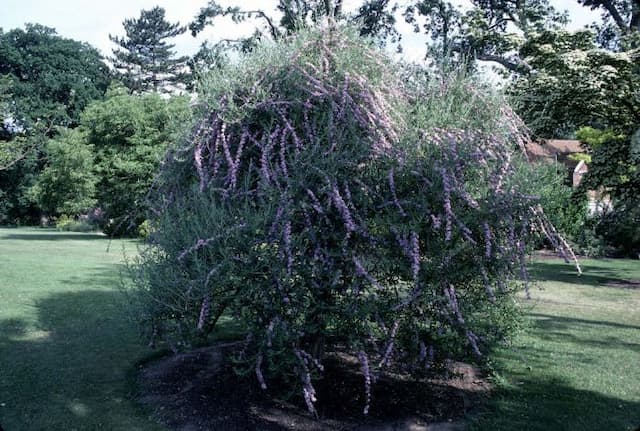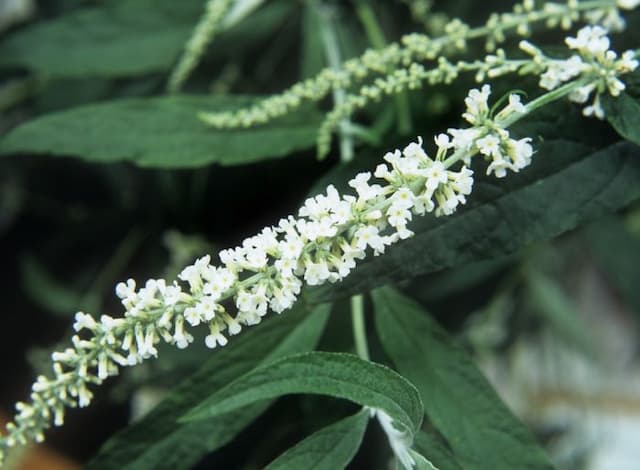Golden Glow Buddleja × weyeriana

ABOUT
The plant known as Buddleja × weyeriana, commonly referred to as Golden Glow, is a hybrid butterfly bush that showcases distinctive features in its appearance. Characteristic of this plant are the flower panicles which bloom in an unusual ball-shaped cluster. These blossoms come in a variety of hues, typically presenting in creamy yellow to orange tones, giving the Golden Glow its name. Each delicate flower within the cluster has a tubular shape which is perfectly designed to attract pollinators such as butterflies and bees. The leaves of Golden Glow contribute to its ornamental value with their lance-shaped structure and subtly serrated edges, offering a textured feel. The foliage has a green-gray coloration which contrasts nicely with the warm-toned flowers, adding to the visual interest of the plant. Golden Glow exhibits a rounded to spreading habit, with branches that arch gracefully under the weight of the blooms and leaves, creating a lush and abundant presence in garden spaces. The overall appearance of Golden Glow is that of a robust and attractive shrub that brings vibrant life and color wherever it is grown, making it a popular choice for gardeners looking to create a lively and butterfly-friendly environment.
About this plant
 Names
NamesFamily
Scrophulariaceae
Synonyms
Butterfly Bush, Golden Butterfly Bush, Hybrid Butterfly Bush
Common names
Buddleja × weyeriana.
 Toxicity
ToxicityTo humans
Butterfly Bush (Buddleja × weyeriana) is not commonly listed as a poisonous plant to humans. However, like with many plants, some individuals may be sensitive or allergic to certain plant parts, causing symptoms such as skin irritation or gastrointestinal discomfort if ingested. If a person is suspected to have ingested butterfly bush and is showing adverse symptoms, medical attention should be sought. It is generally not advisable to consume any part of ornamental plants due to the potential risks and lack of edibility.
To pets
Butterfly Bush (Buddleja × weyeriana) is not commonly known to be toxic to pets such as dogs and cats. However, it is always advisable to prevent pets from eating plants as they might have individual sensitivities or allergic reactions. If a pet ingests any parts of the butterfly bush and shows signs of distress or illness, such as vomiting or diarrhea, it is important to consult a veterinarian. Generally, keeping an eye on pets and discouraging them from chewing on any garden plants is recommended to avoid any potential risks.
 Characteristics
CharacteristicsLife cycle
Perennials
Foliage type
Semi-deciduous
Color of leaves
Green
Flower color
Mixed
Height
5-8 feet (1.5-2.4 meters)
Spread
5-8 feet (1.5-2.4 meters)
Plant type
Shrub
Hardiness zones
5-9
Native area
Hybrid origin
Benefits
 General Benefits
General Benefits- Attracts Wildlife: Buddleja × weyeriana, commonly known as Butterfly Bush, is well known for attracting butterflies, bees, and other pollinators to the garden, helping to support local ecosystems.
- Ornamental Value: With its long panicles of fragrant, colorful flowers that can range from yellow to orange or pink, Butterfly Bush is a popular ornamental plant that adds visual interest to landscapes.
- Drought Tolerance: Once established, Butterfly Bush is quite drought-resistant, making it a suitable choice for gardens in drier climates or areas with water restrictions.
- Fast Growth: Butterfly Bush tends to grow quickly, providing a rapid impact in garden spaces, filling out areas, and creating privacy screens or hedges efficiently.
- Low Maintenance: This plant is considered low maintenance, requiring minimal care once established, which can save time and resources for gardeners.
- Soil Adaptability: Butterfly Bush is adaptable to a variety of soil types, though it prefers well-drained soil, making it versatile for different garden settings.
- Seasonal Interest: With a long blooming period from early summer to autumn, Butterfly Bush provides continuous interest and color throughout much of the growing season.
- Easy Propagation: The plant can be easily propagated from cuttings, allowing gardeners to expand their plantings or share with others without purchasing new plants.
 Medical Properties
Medical PropertiesThis plant is not used for medical purposes.
 Air-purifying Qualities
Air-purifying QualitiesThis plant is not specifically known for air purifying qualities.
 Other Uses
Other Uses- Buddleia x weyeriana, commonly called Golden Glow, can be used in butterfly gardens to attract a variety of butterflies and other pollinators with its nectar-rich flowers.
- Because of its rapid growth and dense foliage, Golden Glow can serve as a natural privacy screen or living fence in gardens and along property lines.
- The plant is often used in mixed borders and cottage gardens to add height and a burst of summer color, complementing herbaceous perennials and shrubs.
- In urban environments, Golden Glow can be planted to create green roofs and vertical gardens, helping to improve the aesthetic of buildings.
- Some gardeners use the drooping branches of Golden Glow to create a weeping effect in landscape designs, especially when planted on slopes or terraces.
- The wood from Buddleia x weyeriana can be used in small woodworking projects, such as making handles for garden tools, due to its medium density and ease of workability.
- The dried seed heads and branches of Golden Glow can be utilized in floral arrangements and wreaths for rustic or natural-themed decor.
- Buddleia x weyeriana can be included in sensory gardens for its fragrance and textural foliage, providing a sensory experience to visitors.
- The plant's ability to grow in poor soils makes Golden Glow an excellent candidate for reclaiming and beautifying disturbed sites or wastelands.
- Educational institutions and conservation groups might use Golden Glow in teaching gardens to demonstrate the importance of plant-pollinator relationships.
Interesting Facts
 Feng Shui
Feng ShuiThe Butterfly Bush is not used in Feng Shui practice.
 Zodiac Sign Compitability
Zodiac Sign CompitabilityThe Butterfly Bush is not used in astrology practice.
 Plant Symbolism
Plant Symbolism- Renewal: B. x weyeriana, commonly known as "Golden Glow", often symbolizes renewal because of its ability to attract butterflies, which are often associated with transformation and new beginnings.
- Attraction: Since "Golden Glow" is known for its ability to attract a variety of pollinators, it also symbolizes attraction and magnetism in certain cultures.
- Peace: In some gardening circles, "Golden Glow" is considered a plant that brings peace to the garden, possibly because of its gentle appearance and calming effect on the environment.
- Prosperity: The vibrant growth and abundance of flowers can represent prosperity, suggesting flourishing and the thriving of one's endeavors, just as the plant blossoms abundantly.
 Water
WaterButterfly Bush should be watered deeply but infrequently, allowing the soil to become somewhat dry between watering sessions. During the growing season, a general guideline is to water once a week, applying approximately 1 to 1.5 gallons depending on the size of the plant and the weather conditions. Overwatering can lead to root rot, so ensure proper drainage. In hot, dry spells, you may need to increase watering frequency to prevent stress. During the winter months, reduce watering significantly, as the plant will be in dormancy and require less moisture.
 Light
LightButterfly Bush thrives in full sun, meaning it should receive at least 6 to 8 hours of direct sunlight a day for optimal growth and flowering. Planting in a south-facing location will ensure it receives adequate light. Partial shade is tolerated but may result in fewer blooms and a less vigorous plant.
 Temperature
TemperatureButterfly Bush typically does well in a wide range of temperatures, enduring minimums down to about 20°F and can survive short periods of colder temperatures, but it may experience dieback. Ideally, it flourishes in temperatures between 60°F and 90°F. Providing a protective mulch layer can help insulate roots during sudden temperature drops.
 Pruning
PruningPruning Butterfly Bush is essential to encourage new growth and abundant flowering. Prune in late winter or early spring before new growth begins, cutting back to about a foot above the ground, as this plant blooms on new wood. Deadheading spent flowers during the season can also promote continued blooming.
 Cleaning
CleaningAs needed
 Soil
SoilButterfly Bush (Buddleia x weyeriana) thrives in well-draining soil enriched with organic matter and prefers a slightly acidic to neutral pH between 6.0 and 7.0. A mix composed of garden soil, compost, and perlite or coarse sand will ensure proper drainage and fertility.
 Repotting
RepottingButterfly Bushes typically do not require frequent repotting and can thrive in the same pot for several years. However, if growth is stunted or the plant becomes root-bound, repotting in the spring every 2 to 3 years is sufficient.
 Humidity & Misting
Humidity & MistingButterfly Bush (Buddleia x weyeriana) is adaptable to a wide range of humidity levels and does not require a specific humidity to thrive, making it suitable for most outdoor environments.
 Suitable locations
Suitable locationsIndoor
Place Butterfly Bush in bright, indirect light indoors.
Outdoor
Plant in sunny spot, protect from strong winds.
Hardiness zone
5-9 USDA
 Life cycle
Life cycleBuddleja × weyeriana, commonly known as the Butterfly Bush, begins its life cycle as a seed that germinates in moist, well-drained soil when temperatures are warm in spring. The seedling emerges and develops into a young plant with characteristic lance-shaped leaves, undergoing vegetative growth during the spring and summer months. The plant enters the reproductive stage and flowers in mid to late summer, attracting butterflies and other pollinators with its fragrant, colorful panicles. After pollination, seeds are produced and dispersed, often by wind or with the help of animals, to propagate the next generation. Throughout fall and winter, the plant may enter a dormancy phase, where growth slows and deciduous varieties lose their leaves, conserving energy for the next growing season. Perennial in nature, Buddleja × weyeriana can live for several years, during which time it will continue to grow, flower, and produce seeds annually.
 Propogation
PropogationPropogation time
Spring-Early Summer
Buddleja × weyeriana, commonly known as Butterfly Bush, is often propagated through semi-hardwood cuttings. The most suitable time for taking cuttings is in late summer to early fall. To propagate, a gardener would select a healthy, semi-hardwood stem that is about 6 inches (approximately 15 centimeters) long with several leaf nodes. Leaves on the lower half of the cutting should be removed, and the cut end can be dipped in rooting hormone to encourage root growth. This treated cutting is then planted in a well-draining soil mix, ensuring at least one or two nodes are buried where roots will form. The cutting requires consistent moisture and should be kept in a warm environment with indirect sunlight until roots have developed, which typically takes several weeks.




![Butterfly bush [Florence]](/_next/image?url=https%3A%2F%2Fplants-admin.emdemapps.com%2Fimages%2Fplants%2F%2Fimages%2F604b5f52d7bb1.png&w=640&q=75)




